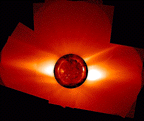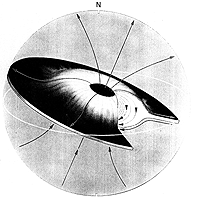 The Solar Wind
The Solar Wind The Solar Wind
The Solar WindThe solar wind is now know to be a mixture of materials found in the solar plasma, composed of ionized hydrogen (electrons and protons) with an 8% component of helium and trace amounts of heavy ions. The solar wind has been detected inward toward the sun to the orbit of Mercury, and outward past the orbits of Uranus and Neptune. The flux of particles is modulated by the pressure (both magnetic and thermal) at the base of the wind in the solar corona, and to a certain extent, some of the features of the solar wind, particularlly in the case of high speed streams, can be identified with specific large scale coronal features, the coronal hole structures.
At the orbit of the earth the average solar wind consists of a strongly ionized gas having a proton and electron density of about 3 - 10 particles per cubic centimeter, with an average flow velocity of approximately 400 km/s. Occasionally stream structures are detected in the steady solar wind, which have peak velocities which tend toward a mean of about 750 km/s near the earth. Occasionally impulsive events are detected with peak velocities in excess of 1000 km/s. Assuming a brief period of acceleration in the low corona, material in the normal solar wind near the equator reaches the earth about 4 days after departing from the Sun. Temperatures of the plasma at the earth are found to be about 150,000°K, approximately a factor of ten lower than the estimates for the temperatures of the bulk of the coronal plasma found in the upper atmosphere of the Sun.

The physical mechanism responsible for the solar wind is the difference in pressure between the corona and a point in space located (say) at the earth. Using average temperature and density values between the lower corona and the solar wind measured at the earth, the difference in pressure is of the order of a factor of a million, causing outward flow. Since the electrical conductivity of the wind material is very high, the plasma being nearly fully ionized, the solar magnetic field lines are frozen into the material, and since the material flows outward from a rotating star, the flow and field patterns take on the general form of a spiral. The solar wind, in fact, is the medium which connects the magnetic variation of the Sun out through the heliosphere, the volume of interplanetary space which is influenced by solar magnetic fields, to various bodies found in the solar system. The scientific interest in the solar wind stems from this fact, and has held the attention of researchers for two reasons: (1) To the extent that the physics of the solar wind is known, it is possible to establish causality, and establish predictive capability for solar-geophysical events. (2) The wide range of physical conditions found in the solar wind and its interactions with magnetized and non-magnetized planets, dust, cosmic rays, comets, and spacecraft allow the investigation of physical mechanisms not easily duplicated in the terrestrial laboratory. Many contributions to the basic understanding of plasma processes have been identified and understood in the context of the solar wind. Numerous problems await further investigation and resolution.
Joint SPARTAN 201-Ulysses operations are aimed at the collection of a complete observational picture of the solar wind from the polar regions. The Ulysses spacecraft carries instruments which will sample the temperature, density, velocity, and magnetic field configuration in the location of the spacecraft which will be over the solar polar region and at a distance of about 2.2 times the distance from the earth to the Sun. The SPARTAN instruments, observing at the same time, will measure the density and temperature of the proton and electron components of the corona, attempting to establish boundary conditions for the initial state of the solar wind as it departs on its path out of the solar system.